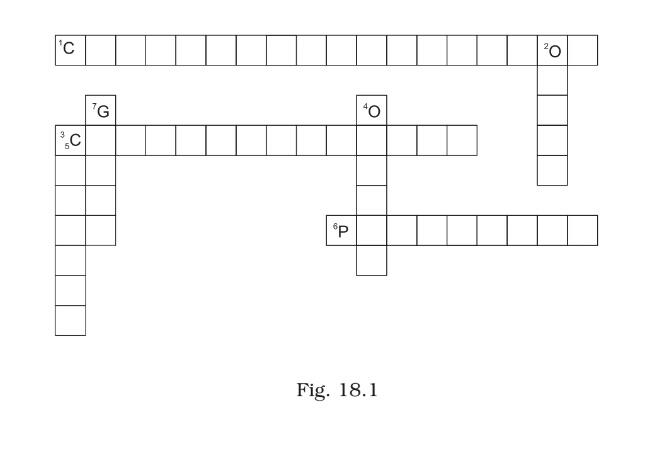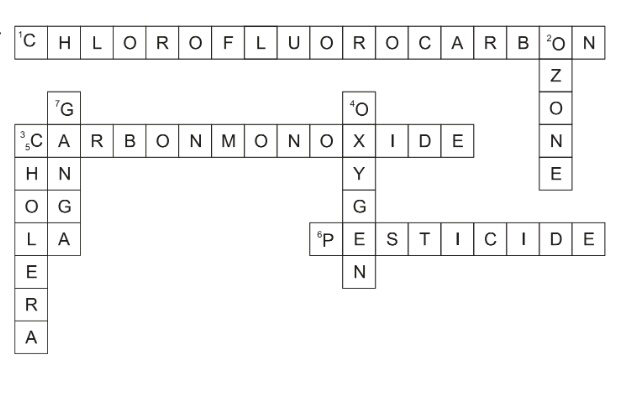Science
Chapter 18: Pollution of Air and Water
Class: VIII
Exemplar Solutions
MULTIPLE CHOICE QUESTIONS
Question 1
Air is a mixture of various gases. One of the gases is 21% part of the air and is essential for the survival of human beings. This gas is
(a) nitrogen (c) ozone
(b) oxygen (d) argon
Answer 1 (b)
Question 2
Which of the following is not a source of air pollution?
(a) automobile exhaust (c) windmill
(b) burning of firewood (d) power plant
Answer 2 (c)
Question 3
Boojho wishes to contribute in reducing air pollution. Which vehicle should he use for going to school?
(a) car (c) autorickshaw
(b) school bus (d) scooter
Answer 3 (b)
Question 4
Which of the following is not a way to conserve water?
(a) replace (c) reuse
(b) reduce (d) recycle
Answer 4 (a)
Question 5
The type of pollution which is likely to affect Taj Mahal in Agra to a greater extent is
(a) air pollution (c) soil pollution
(b) water pollution (d) noise pollution
Answer 5 (a)
Question 6
Incomplete combustion of fuel such as petrol and diesel gives
(a) nitrogen oxide (c) carbon monoxide
(b) sulphur dioxide (d) carbon dioxide
Answer 6 (c)
Question 7
The phenomenon of marble cancer is due to
(a) soot particles (c) fog
(b) CFCs (d) acid rain
Answer 7 (d)
Question 8
Potable water is the water which is
(a) obtained from a river. (c) pure and fit for drinking.
(b) obtained from a lake. (d) used only for washing clothes.
Answer 8 (c)
Question 9
Which of the following procedures will give you water free from all impurities?
(a) adding chlorine tablets (c) boiling
(b) distillation (d) filtration
Answer 9 (b)
Question 10
A pond contains clean water. Which of the following activities will produce least pollution of water?
(a) washing clothes in the pond
(b) animals bathing in the pond
(c) washing motor vehicles in the pond
(d) swimming in the pond.
Answer 10 (d)
Question 11
Trees help in reducing the pollution of our environment. Lakhs of trees are planted by people in the month of July every year. The occasion is called
(a) forest Conservation Day (c) Van Mahotsav
(b) plantation month (d) wildlife week
Answer 11 (c)
Question 12
Which of the following is not a green house gas?
(a) nitrogen gas (c) methane gas
(b) water vapour (d) carbon dioxide
Answer 12 (a)
VERY SHORT ANSWER QUESTIONS
Question 13
Name the chemicals which are used in refrigerators and air conditioners and damage ozone layer when released in air.
Answer 13
Chlorofluorocarbons.
Question 14
Name any two sources which cause air pollution due to suspended particulate matter.
Answer 14
Question 15
Name two gases which are mainly responsible for acid rain?
Answer 15
Question 16
The quality of air at various locations is monitored regularly by government and other agencies? In what way can you use these data?
Answer 16
These data can be used to generate awareness about air pollution among people.
Question 17
Combustion of fossil fuels generates a lot of air pollution. Can you suggest any two alternative sources of energy which do not cause any pollution?
Answer 17
Solar energy and wind energy.
Question 18
Name any two water pollutants which are toxic for plants and animals.
Answer 18
Lead, arsenic, fluorides (any two)
SHORT ANSWER QUESTIONS
Question 19
A lot of dry leaves are collected in a school garden and are burnt every day. Do you think that it is right to do so? If not, what should be done to dispose off the dry leaves?
Answer 19
It is not right to burn dry leaves as it causes air pollution. The right way to dispose off the dry leaves is to convert them into compost.
Question 20
The level of air pollution is higher at a busy traffic intersection. Why?
Answer 20
A large number of automobiles stop for a short period at red light through out the day and release a large quantity of gases which create air pollution.
Question 21
Fill in the blanks with the help of words given in bracket after each sentence.
(a) When air is contaminated by ________ substances which have a ________ effect on both the ________ and ________, it is referred to as ________. (air pollution, harmful, living, unwanted, non-living, pollutants).
(b) Many ________ are responsible for causing ________ pollution. Petroleum ________ are a major source of ________ pollutants like ________ and ________. (sulphur dioxide, refineries, industries, nitrogen dioxide, gaseous, liquid, people, air).
(c) While ________ your teeth, leaving the ________ running may waste several ________ of water. (tap, litres, brushing, washing, drops)
(d) Water which is suitable for _________ is called ________ water. (washing, bathing, drinking, potable, soft).
(e) Water which looks clean still has disease carrying ________ and ________ impurities. (insects, microorganism, particles, dissolved, harmful).
Answer 21
(a) unwanted, harmful, living, non-living, air pollution.
(b) industries, air, refineries, gaseous, sulphur dioxide, nitrogen dioxide.
(c) brushing, tap, litres
(d) drinking, potable
(e) microorganisms, dissolved.
Question 22
Match the items of Column A with those of Column B.
|
Column A |
Column B |
|
(a) sulphur dioxide (b) carbon dioxide (c) carbon monoxide (d) chlorofluorocarbons |
(i) damage ozone layer (ii) reduces oxygencarrying capacity of blood (iii) acid rain. (iv) green house gas |
Answer 22
(a)–(iii), (b)–(iv), (c)–(ii), (d)–(i)
Question 23
Find out the wrong statements and write them in their correct form.
(a) We can survive for some time without air but we cannot survive even for a few minutes without food.
(b) A brick kiln emits lot of smoke and other harmful gases causing air pollution.
(c) Carbon monoxide is produced by complete burning of fuels such as coal, petrol, diesel.
(d) Chlorination is a commonly used chemical method for killing germs in water.
(e) Water which is suitable for drinking is called soft water.
Answer 23
Statements (b) and (d) are correct statements. The correct form of statements (a), (c) and (e) are as follows
(a) We can survive for some time without food but we cannot survive even for a few minutes without air.
(c) Carbon monoxide is produced by incomplete burning of fuels such as coal, petrol, diesel.
(e) Water which is suitable for drinking is called potable water.
Question 24
In the following statements, the underlined words are jumbled up. Write them in their correct form. (a) Air contains 78% ginroten and 21% gonexy.
(b) Vehicles produce high level of pollutants like carbon dioxide, nitrogen oxides, nobrac moondexi and mosek.
(c) Carbon dioxide, thaneme, nitrous oxide and water vapour are known as heengrouse sesga.
(d) Gangotri glacier in Himalaya has started melting because of lablog ringwam.
(e) Whenever harmful substances such as wagese, toxic chemicals, silt, etc. get mixed with water, the water becomes potdulle.
Answer 24
(a) nitrogen, oxygen
(b) carbon monoxide, smoke
(c) Methane, greenhouse gases
(d) global warming
(e) sewage, polluted
LONG ANSWER QUESTIONS
Question 25
What do CFCs stand for? Name some devices where CFCs are used. Why CFCs are considered as pollutants?
Answer 25
Hint:
– CFCs stand for chlorofluorocarbons.
– Refrigerators, air conditioners etc.
– Damage the ozone layer of the atmosphere.
Question 26
Why is it advised that industries should switch over to cleaner fuels such as CNG and LPG in the Taj Mahal Zone in Agra?
Answer 26
Hint: Pollutants in air are discolouring white marble of Taj Mahal. The pollutants like sulphur dioxide and nitrogen dioxide react with the water vapour present in the atmosphere to form sulphuric acid and nitric acid respectively.
Question 27
It is said, "CO2 contributes to global warming." Explain.
Answer 27
Hint: CO2 takes heat and does not allow it to escape into space. As a result, the average temperature of the earth’s atmosphere is gradually increasing.
Question 28
We should plant trees and nurture the ones already present in the neighbourhood. Why?
Answer 28
Hint:
– To reduce air pollution.
– To control global warming.
Question 29
Explain the traditional way of purifying water to make it fit for drinking.
Answer 29
Hint:
Question 30
How can we reduce, reuse and recycle water?
Answer 30
Hint:
Reduce – While brushing your teeth, bathing etc.. we should not keep our taps on.
Reuse – Water used for washing vegetables, rice etc. can be used for gardening.
Recycle – Dirty water can be recycled after purification.
Question 31
Read the paragraph and answer the questions following it.
Water is essential for life. Without water there would be no life. We usually take water as granted for its purity, but we must ensure the quality of water. Pollution of water originates from human activities. Through different paths, pollution reaches to ground water. Easily identified source or place of pollution is called as point source, e.g.– municipal and industrial discharge pipes, where pollutants enter the water source. Non–point sources of pollution are those where a source of pollution can not be easily identified, e.g.– agricultural run off, acid rain etc.
(i) How do you classify the various sources of water pollution?
(ii) What are the point sources of water pollution?
(iii) Name any two non-point sources of water pollution?
Answer 31
Question 32
Complete the crossword puzzle with the help of clues given below:

|
Across |
Down |
|
1. Pollutant which was used and air us from harmful conditioners. (18) 3. Produced on incomplete combustion of fuels. (14) 6. This chemical protects our crops and is washed into water bodies from the field. (9) |
2. This layer protects us from harmful ultraviolet rays. (5) 4. It is essential for combustion. (6) 5. Disease which is caused by drinking contaminated water. (7) 7. River which is famous in India and sustains most of the northern, central and eastern Indian population. (5) |
Answer 32

Yearlong program for Olympiads preparation & to build necessary skills for future.
Explore More
Time to mark your calendar with the upcoming Olympiads exam schedule.
Explore More
Take your Olympiad preparation to next-level by taking LIVE Classes.
Explore More
Assess your performance by taking topic-wise and full length mock tests.
Explore More
Online tuitions for international compeitions like SASMO, SEAMO, etc for Grades 1-11.
Explore More